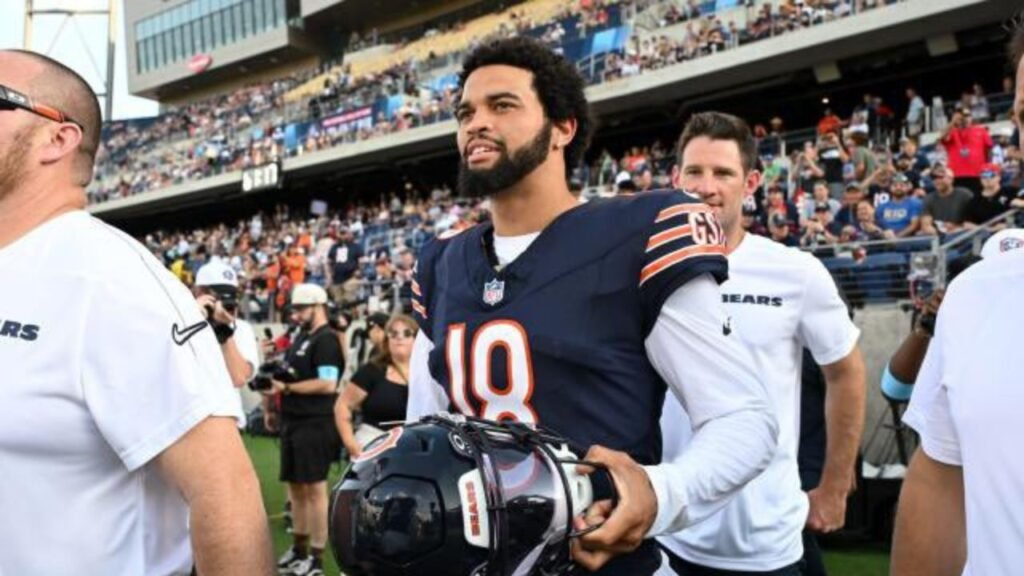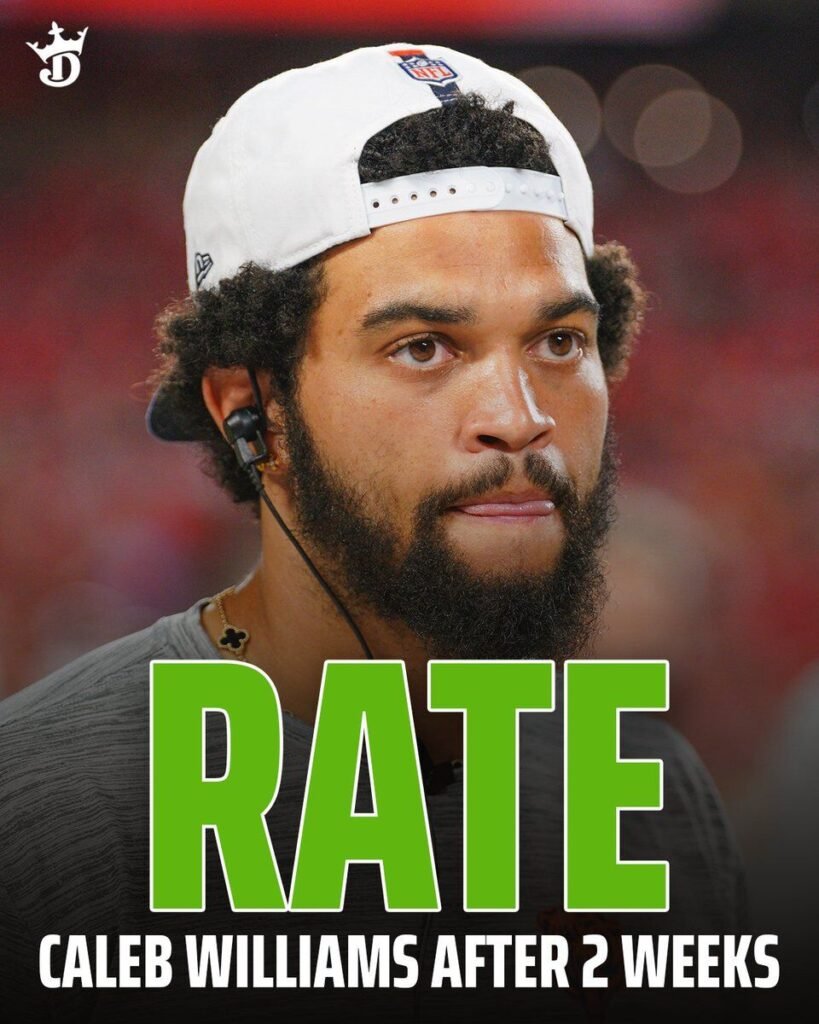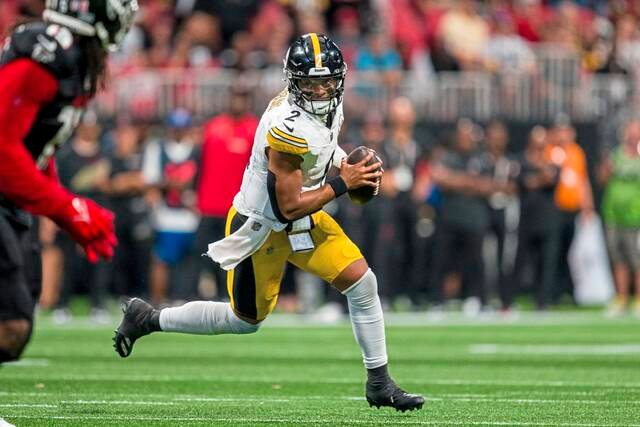Caleb Williams Under Siege: What The Bears Must Change
- Leave a Comment
- William D
- September 16, 2024

The Chicago Bears encountered a recurring nightmare in a valiant 19-13 defeat to the Houston Texans: an overburdened quarterback battling under constant pressure.
The Bears’ highly anticipated first-round draft pick, Caleb Williams, experienced consistent pressure from the Texans’ relentless defense, taking seven sacks and being harassed.
Williams had numerous protection-related mishaps during his performance, which left him hurt and bruised despite his obvious aptitude and potential.
Williams’ issues in this game are reminiscent of those of Justin Fields, the quarterback who came before him and similarly encountered a lot of pressure and insufficient protection when playing for the Bears.
Fields was frequently left on his own behind a struggling offensive line, and Williams is currently dealing with similar problems.
A concerning trend for Chicago is highlighted by the recurrent theme of a young quarterback feeling let down by his team’s failure to create a reliable pocket.
The similarities between Fields’ previous struggles and Williams’ present predicament underscore how urgently the Bears must resolve their offensive line issues.
Given the team’s past struggles in protecting its quarterbacks, it seems likely that Williams will have a career that is a lot like Fields’ if not for some big changes.
To avoid a recurrence of the past, the Bears must use the lessons learned from previous setbacks as they continue to assemble their team around a talented young quarterback.

The Texans' C.J. Stroud blueprint
The Houston Texans have proven to have a well-defined and efficient plan in place for safeguarding their inexperienced quarterback, C.J. Stroud.
Stroud has prospered this season behind an organized offensive line that gives him the consistency he needs to be successful.
Building their offense around Stroud has paid off for the Texans, who have demonstrated a viable recipe for preserving quarterback health and production.
The Texans’ commitment to a well-balanced running game has been a crucial component of their philosophy. The front office in Houston made a lot of moves to strengthen their backfield, keeping excellent running back Dameon Pierce and adding well-known players like Joe Mixon and Cam Akers.
The combination of these three running backs is intended to produce a strong and versatile rushing assault that not only helps gain yardage on the ground but also significantly lessens Stroud’s pressure by making defenders respect both the run and the pass.
Maintaining a strong offensive line has been equally vital for the Texans. Stroud will have the protection he needs to execute plays since the offensive line has been carefully developed and refined.
The offensive line is able to operate as a unit because to this protection, giving Stroud the time he needs to assess the field and execute accurate throws instead of feeling pressured to make snap judgments.
The Texans’ game statistics clearly demonstrate the outcome of this well-rounded offensive strategy. Houston has demonstrated a balanced distribution of passing and rushing attempts in their recent games.
For example, the Texans showed that they were committed to preserving offensive balance in Week 1 by dividing their 36 rushing attempts between wide receivers and running backs.
This tactic not only keeps opposing defenses guessing, but it also makes sure that Stroud doesn’t get too many throw attempts, which lessens the chance of pressure and sacks for him. This well-rounded strategy has worked well in establishing a steady and fruitful offensive atmosphere for Stroud.
WOW… #Bears star receiver DJ Moore is PISSED OFF & FED UP after Caleb Williams missed him on a big throw again.
— MLFootball (@_MLFootball) September 16, 2024
He says something to backup QB Tyson Bagent … “DAWG I …..”
😳👀
pic.twitter.com/81aEM4SeMx
The Bears' Offensive Battles
The Chicago Bears’ recent performance against the Houston Texans highlights how concerning the offensive line has been. Caleb Williams is exposed as a result of the line’s incapacity to consistently cover him; opponents routinely break through the pocket and put him in awkward positions.
This ongoing problem has resulted in sacks and pressures on a regular basis, which has undermined the offensive effectiveness of the Bears and increased the burden on Williams to perform under duress.
The Bears’ inability to produce a consistent running game is making matters worse. Chicago has had trouble establishing a reliable rushing attack, in contrast to the Texans who have made significant investments in a strong backfield to assist their quarterback.
Williams is under more pressure now that he is not as strong in the run game as he is because defenders can concentrate more on pass rushing without having to worry about Williams’ strong running game.
Williams is frequently exposed to aggressive opponents in the lack of a balanced offensive strategy, which increases the quantity of hits he takes and the frequency of sacks.
It is impossible to ignore how offensive coordinator Shane Waldron contributed to the situation getting worse. Waldron was expected to provide the Bears with a well-rounded offensive plan, but he has fallen short in this regard.
Williams is under unnecessary strain as a result of his inability to combine a passing assault with a viable rushing game.
The Bears’ attack is now predictable and easy for defenses to exploit due to ineffective game planning and changes, which exacerbates the problems with the offensive line.
Williams’s previous performances make it quite clear that he struggles under pressure. 36 out of 37 dropbacks against the Texans were under pressure, and he was sacked seven times.
This unrelenting assault has affected Williams’ accuracy and decision-making in addition to resulting in a large amount of sacks. Williams has not been able to reach his full ability since he has been forced to make quick throws and avoid defenders.
In order to adequately assist their rookie quarterback, the Bears must critically evaluate their offensive approach and rectify the line’s shortcomings, as evidenced by the persistent breakdowns in protection.
Bill Belichick wasn’t buying the Caleb Williams preseason hype
— Barstool Sports (@barstoolsports) September 16, 2024
pic.twitter.com/bwmLFJZ0Rv
During the Bears’ game against the Texans, there were multiple pivotal occasions where their offensive line shortcomings were clearly visible.
When the game was still in reach late in the fourth quarter, one of the most significant incidents took place. Bears right tackle Darnell Wright failed to block Texans defensive end Danielle Hunter on a pivotal drive.
Hunter’s uncontested rush caused Caleb Williams to be sack for eight yards, thereby stopping the Bears’ momentum and guaranteeing their defeat.
This play brought to light not only Wright’s incomplete assignment but also the offensive line’s general failure in execution and communication.
Another crucial moment occurred early in the game when Williams was under constant siege from many directions. Williams had to scurry more than once to escape sacks as the Texans’ defensive line successfully exposed gaps in the Bears’ line.
Williams’s ability to set his feet and execute accurate passes was compromised by the constant pressure, which forced him into rushed throws. With no defense to break up the offensive flow, Williams found it impossible to play with any kind of regularity.
This ongoing pressure had a clear effect on Williams’ performance. Williams frequently misfired on important throws or sailed passes over his intended receivers when forced to make snap decisions.
One such case involved Williams being under pressure from a collapsing pocket and misfiring on a deep pass intended for rookie wideout Rome Odunze, missing by a considerable margin.
The Bears’ inability to provide him a clear pocket led directly to this lost opportunity, illustrating how the offensive line’s problems affected the passing game’s efficacy.
All things considered, these pivotal plays highlighted a larger problem with the Bears offensive line and their incapacity to shield Williams. Not only did the repeated breakdowns result in crucial sacks, but they also made Williams throw erratically and in a hurry.
All of these mistakes combined to cause a disruption in the offensive flow and a quarterback who was unable to perform well under pressure. In order to prevent such setbacks in the future and to give their young quarterback the assistance he needs to thrive, the Bears must address these concerns.

For the Chicago Bears to see a young quarterback like Caleb Williams realize his full potential, they must protect him. The success of the Texans with C.J. Stroud highlights how crucial it is to offer a strong foundation of protection.
Behind a solid offensive line that has given him the confidence and poise to make plays, Stroud has thrived.
The Bears need to provide a similar atmosphere for Williams so that he can function well in a reliable offensive structure and is protected from unrelenting pressure.
The Texans’ approach with Stroud demonstrates the importance of a well-rounded offensive scheme in attaining this protection.
Houston’s dedication to a varied offensive strategy that includes a smart passing game in addition to a strong rushing attack has been crucial in keeping their quarterback safe.
The Texans have made things easier for Stroud by making sure that other teams can’t concentrate just on pass rushers.
Similar to this, the Bears must incorporate a solid rushing game to support their passing offense and keep teams from taking advantage of holes in their line.
The task facing offensive coordinator Shane Waldron and head coach Matt Eberflus is to develop and sustain a potent run attack. This is crucial in relieving Williams of pressure and giving him the time he needs to run plays well.
The Bears’ current problems offensively may be attributed in large part to their running game woes, which allow defenders to focus on pressuring Williams without worrying about a potent response.
Building a strong running game is a top priority for Eberflus and Waldron in order to help their rookie quarterback and enhance offensive balance as a whole.
There are significant disparities between the Bears’ present configuration and the Texans’ winning plan. While the Bears have suffered with a one-dimensional approach and uneven protection, Houston has developed an offensive framework that supports their quarterback through a balanced assault and a strong offensive line.
The Bears’ current offensive scheme, which hasn’t been able to give Williams the steadiness and assistance he requires, contrasts sharply with the Texans’ ability to successfully combine their passing and rushing game.
The Bears need to improve their running game, solve their offensive line problems, and establish a more stable and safe environment for Williams to play in order to emulate the success of the Texans.
The Bears are at a turning point in their journey to try and stay away from the blunders that dogged Justin Fields’ time on the squad. Fields had a difficult time in Chicago, which was mostly caused by his lack of protection and his incapacity to design a well-rounded attack plan.
The danger now is that if the Bears don’t fix the fundamental problems with their offensive line and overall scheme, Caleb Williams might experience similar setbacks.
If these changes aren’t made, Williams’ development would be hampered, which would mirror Fields’ experiences and possibly impede the advancement of another talented quarterback.
The guidance that C.J. Stroud gave Williams emphasizes how crucial it is to keep an eye on long-term growth even in the face of short-term difficulties.
Stroud, who has faced his own share of struggles, underlined the significance of Williams remaining resilient and not allowing present setbacks to impede his development. For Williams to cope with the demands of being a prominent rookie on a failing team, this viewpoint is essential.
Williams needs to absorb the lesson that Stroud’s experience emphasizes the value of persevering through hardship and having faith in oneself as he makes his way through the Bears’ early season.
The Bears need to give both scheme and protection upgrades top priority in order to avoid making the same mistakes twice. Williams has already demonstrated the negative consequences of the offensive line’s current status and the absence of a well-rounded offensive strategy on his performance.
The Bears must act quickly to resolve these concerns by strengthening the offensive line, improving the rushing game, and designing a play calling plan that benefits Williams rather than always disadvantages him.
Williams’ potential runs a serious risk of being hampered by the same structural issues that beset his predecessors in the absence of these reforms.
The Bears have a vital chance to grow from their past mistakes and create a welcoming environment for Caleb Williams. Chicago may prevent Williams’ development from being hampered by adopting proactive measures, including as learning from Justin Fields’ problems and embracing the Texans’ successful C.J. Stroud techniques.
To avoid the mistakes of the past and pave the road for future success, Williams has to be placed in a nurturing atmosphere where he may fulfill his full potential. This can be achieved by strengthening protection, building a balanced offense, and fixing scheme shortcomings.
Conclusion:
Caleb Williams’ effectiveness has been negatively influenced by the Chicago Bears’ present problems, which include a struggling offensive line, an unbalanced offensive system, and insufficient running support.
Williams is under constant pressure because of the offensive line’s frequent collapses, which are made worse by the absence of a consistent rushing game.
Furthermore, the offensive plan has failed to strike the right mix between rushing and throwing, which has put Williams in a precarious situation with little defense and assistance.
The Bears need to make quick adjustments if they want to turn the round and offer Williams the best opportunity to succeed. It is critical to address the offensive line concerns in order to give Williams the stability he needs to carry out plays with assurance.
In addition, the Bears must devise a more well-rounded offensive strategy that combines a potent running game with their passing assault.
Chicago can provide Williams with a more encouraging environment by implementing these changes, which will lessen his workload and improve his performance.
In the long run, Williams’ and the Bears’ success will rest on their capacity to absorb the lessons from groups such as the Texans. For Chicago, Houston’s strategy with C.J. Stroud, which prioritizes a well-rounded offensive system and strong protection, provides a useful model.
The Bears can prevent making the same mistakes twice and provide Williams the assistance he needs to grow by implementing similar tactics.
By making the necessary changes, the Bears can create a strong foundation for their inexperienced quarterback, setting him up for future success and enabling him to reach his full potential as a franchise player.
